T. Belman. Don’t look to JPOST for honest reporting.. This article doesn’t mention illegal Arab construction after mentioning the increase in demolitions of Arab illegal construction in Bennett’s year in office. Why keep silent about the most important issue?
The presence of left-wing parties in the coalition did little to hinder the ‘change government’ from continuing construction in the West Bank and destroying Palestinian residences
By Hagar Shezaf, JPOST 26.6.22
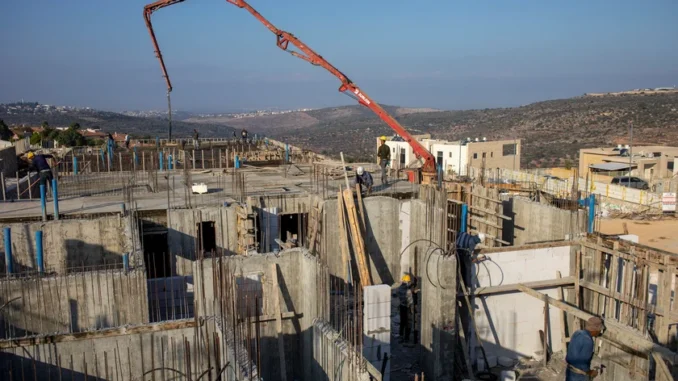
Palestinians built new houses in the West Bank Jewish settlement of Bruchin near the Palestinian town of Nablus, in 2021.Credit: Ariel Schalit /AP
Bracha would be considered a suburb of Nablus, probably going by a different name. The settlement, with its 3,000 residents, abuts the West Bank’s second largest city, but is relatively isolated. When people in Israel talk about “settlement blocs,” they don’t mean this one. And yet, over the last year, under the Bennett-Lapid government, it has taken a few steps to drive further stakes into the ground.
Under the noses of Meretz, Labor and the United Arab List, the government oversaw the construction of a new neighborhood there, with 300 housing units. That is but one example. In fact, in its first and last year in office, the government promoted the construction of thousands of housing units beyond the 1967 borders, mainly outside settlement blocs, deep within the West Bank.
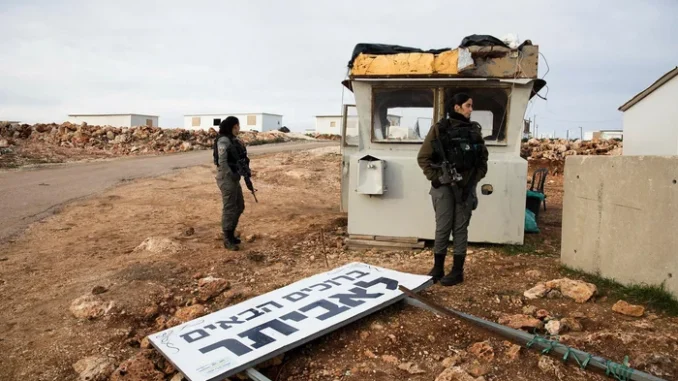
The controversial plan to build in the E1 area near Ma’aleh Adumim was also put into motion recently. Moreover, for the first time, funds were transferred to settlers’ regional councils for the purpose of taking action against Palestinian construction.
If left-wing parties in the unraveling coalition attempt to hide these facts in the coming months, it’s possible that their partners on the right will not rush to reveal other trends from the passing year. These include the augmented law enforcement against the so-called “hilltop youth” settlers, and the fact that a plethora of promises, such as an agreement on the status of the outpost of Evyatarand the hookup of outposts to the national grid are far from being realized.
Construction plans in the settlements
If the story consisted of absolute numbers, the 7,292 new housing units up for approval in the territories would tell the whole story, especially considering that the average under former Prime Minister Benjamin Netanyahu was less than 6,000 a year.
But the figures, compiled by Peace Now, show that things are somewhat more complex. First, because Netanyahu’s last years involved an increase in construction, compared to his earlier years. Second, because most of the plans that received approval still face a long journey before officially being allowed to commence. In fact, only 3,000 units have passed through all the required hoops.
The complexity of these figures is further reflected in the identities of those who made them possible. In contrast to the policies they promote, Meretz and the Labor Party were party to a government that approved construction in isolated settlements, including Har Bracha and Elon Moreh, near Nablus, Kiryat Arba near Hebron, and in Dolev, near Ramallah. Especially prominent was the approval for a five-fold increase of the settlement of Shvut Rachel, located in the heart of the West Bank and not included in the so-called “settlement blocs.” The main person behind all these approvals was Defense Minister Benny Gantz (Kahol Lavan).
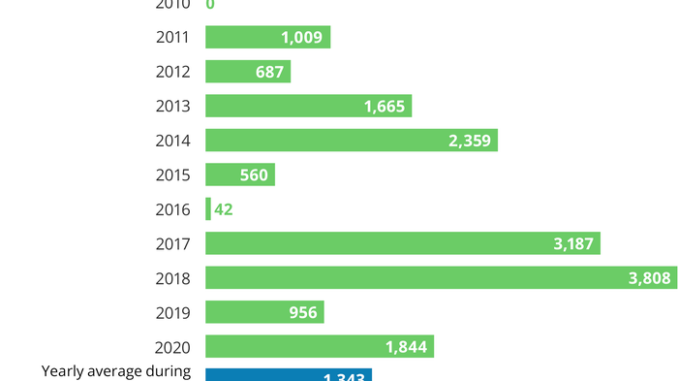
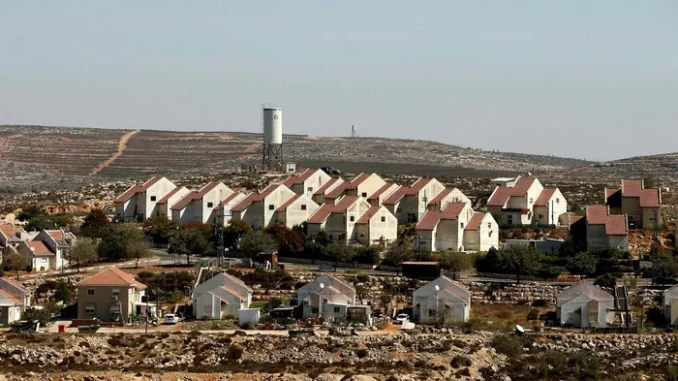
The settlers didn’t welcome the government’s actions either. The Yesha (Judea and Samaria) council believes that the government actually made the situation of construction in the territories worse, citing the fact that the supreme planning committee convened less than in the past (even though in the twilight of Netanyahu’s government it was in no hurry to convene either). Furthermore, they say, not all the planned housing units were brought up for discussion. Settlers say that 2,000 promised housing units have remained on paper.
Construction tenders
Both the settlers and Palestinians know that construction plans could very well be just the first stage. The urban settlements, under the responsibility of the Construction and Housing Ministry, need to issue a competitive bidding tender for contractors for construction – with the approval of the Defense Minister. This rule was definitely applied under the Bennett-Lapid government. According to a report issued by Peace Now, “The government of unequivocal annexation: One year of the Bennett-Lapid Government”, which surveys the present government’s policies concerning the settlements, it seems that a not so short list of tenders exists.
A partial list includes the settlements of Adam, Emanuel, Karnei Shomron and Elkana. One bid that was especially important for the settlers incuded 364 housing units in Beit El – on land where the Binyamin regional brigade is located. The plan has been stalled for a long time because of the high cost of evacuating the army base.
Yet another project is to build a new neighborhood in the city of Ariel with 730 residential units. It would seem as if the project is meant to expand the city, which is a settlement bloc in its own right – but that is not quite true – the new neighborhood does not have territorial continuity with the already constructed area of the city.
- From the Settlers to Biden, Israel’s West Bank Plans Try to Appease Almost All
- Nablus has become Israeli settlers’ violent playground
- Palestinians Eight Times More Likely to Face Home Demolition Than Settlers
Strategic plans
E1, a term which seems to have been resigned to the history books, made a surprising return, and became relevant once again. At the end of May, the state informed the High Court of Justice that the large construction plan near Jerusalem, a part of Ma’aleh Adumim, is back on the agenda, despite having drawn quite a bit of international criticism. This might be the most controversial plan in the West Bank. It is particularly worrisome for the international community, which believes that, should the plan come together, it could put an end to the two-state solution.
Next month, a hearing will be held on the objections to the plan, and it is possible that with the dissolution of the Knesset, there will be renewed political opposition.
Over the past month, construction has begun on an elevator at the Tomb of the Patriarchs in Hebron, a project intended to make the holy site accessible to disabled persons on the Jewish side of the complex.
For years, the project was delayed because of a long list of court petitions by left wing groups and Palestinians. Ultimatly, all of the petitions were denied and the project is now underway. This is not the only plan concerning Hebron: This year, construction began on a new Jewish neighborhood with 31 housing units in the old city.
Outposts
Though one cannot credit the government – or alternatively to condemn it – for the outposts that went up over the past year, according to Peace Now, six new outposts have been constructed under the Bennett-Lapid gvernment: Givat Hadegel in the southern Hebron Hills, Karnei Re’em in the Salfit area, Havay Mevo’ot Yeriho north of Jericho, the Yulious farm in the northern Jordan Valley, the eastern farm of Neria in the Jordan Valley, and Givat Ohavei-Yah west of Bethlehem.
Most of them are farm outposts, meaning they do not make use of the land for construction but take control of it for pastureland. That is why, in principle, they are more easily removed than the outposts that have larger numbers of residents. For example Givat Ohavei-Yah was demolished this week – though not for the first time – and a closed military zone order was issued for the site for one year.
In general, the Bennett-Lapid government took pride in its relatively low tolerance concerning the establishment of outposts. Outposts built by the Hilltop Youth have been removed much more frequently than the Civil Administration has done in the past.
While putting up an outpost can be done without the government necessarily agreeing, making an existing outpost legal is a whole different story. There are three in this category: Mitzpe Dani, Oz and Givat Habustan. At the same time, a few steps were taken on the way to legalizing older and more established outposts that been advancing in this direction. The objections to one of them, Adi Ad, was dismissed in April.
Another example is Havat Yair, which was connected to the electrical grid – according to the settlers, as part of a promise given back in the days of the Netanyahu government. Under the present government, connecting outposts to the electrical grid was the most important priority for MK Nir Orbach of the Yamina party.
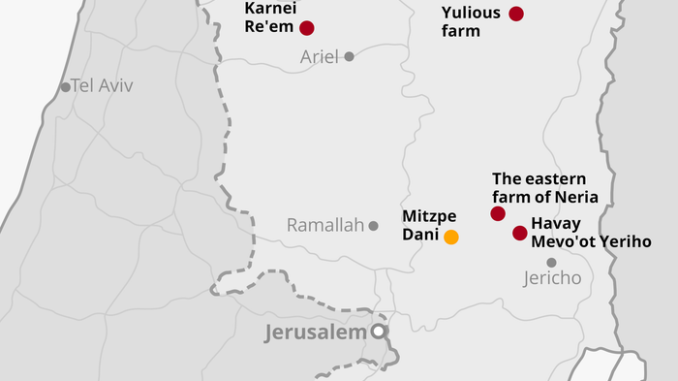
As a condition for his vote in favor of the law to connect unrecognized Bedouin communities to the electrical grid, Orbach asked to allow a large number of outposts that have not yet been legalized to connect to the Israel Electric Corporation network. According to a defense official, the order is still being worked over by legal teams and is not expected to be approved anytime soon. In light of the political developments, it is doubtful whether it will happen while the present government is still in office.
One of the first names that appeared on the Bennett – Lapid government’s road map was Evyatar. The outpost, which went up on land above the Palestinian town of Beita during Operation Guardian of the Walls in the Gaza Strip in May 2021– with houses built and roads paved – seemingly entered the fast track for legalization in the early days of the government.
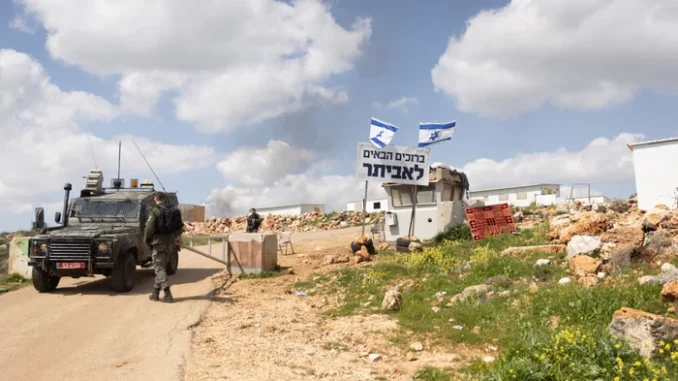
The entrance to the outpost of Evyatar in March.Credit: Moti Milrod
The government signed an agreement with the settlers in which they would evacuate and the government would start the process of examining legalizing the status of the land. The government promised that if it was possible, a yeshiva or community would be built there. None of this actually happened, and with the government running out of time, it’s doubtful any of it ever will. Regardless, Palestinians are still forbidden to enter the site and the army is deployed on the hill 24 hours a day.
Demolishing Palestinian structures
This past year came in third in the dubious competition of most Palestinian structures demolished since 2009, with 2016 and 2020 taking first and second place. The total was 614 buildings, according to the United Nations Office for the Coordination of Humanitarian Affairs (OCHA). Not all of these structures were residences at the time of their demolition; some were empty, others were used for agriculture or kitchens. At the top of the list of demolitions was Ras al-Tin, a community of shepherds who live in the area near Kochav Hashahar, where 84 people lost their homes.
But it wasn’t all about destruction for the Palestinians. The numbers may be relatively small compared to construction for settlers, but over the past year, the construction of 1,303 housing units for Palestinians was advanced – the highest number in years. However, over 1,100 of these units have only made it through the preliminary approval stage, and it seems it will take a very long time before the Palestinians see bulldozers coming to do something other than demolish.
Advancing construction for Palestinains on paper didn’t last long either. After the Yesha Council of settlements condemned the move, advancing construction in the West Bank was halted – for anyone who isn’t a settler that is.

Enforcement budgets
One of the innovations in allocating funds in the West Bank over the past year is a sort of dowry from the previous Netanyahu government: 18.6 million shekels ($5.4 million) were allocated to the settlements for the purpose of establishing a land survey department.
The goal was clear – to survey and map out illegal Palestinian construction in Area C and to report on it to the Civil Administration, the body in charge of law enforcement in the West Bank. Along with the salaries of inspectors in the field, this budget funded drones, the purchase of arial photographs, fencing, vehicles and Arabic lessons for the inspectors – and it is not yet clear if this budget will be renewed next year.
An only slightly smaller sum, 18.5 million shekels, was budgeted for “the battle for Area C,” the title given to the Israeli government’s attempts to curb illegal Palestinian construction. The budget is the result of the coalition agreement between Yamina and Yesh Atid, and is earmarked to pay for an additional 46 employees of the Civil Administration,15 of whom will take part in this supervisory unit.



Leave a Reply
You must be logged in to post a comment.